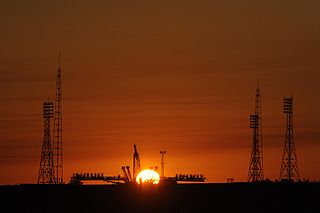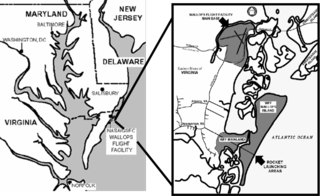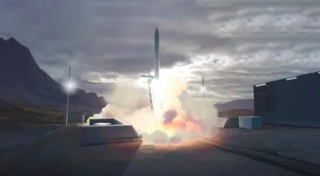
A spaceport or cosmodrome is a site for launching or receiving spacecraft, by analogy to a seaport for ships or an airport for aircraft. The word spaceport, and even more so cosmodrome, has traditionally been used for sites capable of launching spacecraft into orbit around Earth or on interplanetary trajectories. However, rocket launch sites for purely sub-orbital flights are sometimes called spaceports, as in recent years new and proposed sites for suborbital human flights have been frequently referred to or named "spaceports". Space stations and proposed future bases on the Moon are sometimes called spaceports, in particular if intended as a base for further journeys.

The Guiana Space Centre, also called Europe's Spaceport, is a European spaceport to the northwest of Kourou in French Guiana, a region of France in South America. Kourou is located approximately 310 mi (500 km) north of the equator at a latitude of 5°. In operation since 1968, it is a suitable location for a spaceport because of its equatorial location and open sea to the east.

Cape York Peninsula is a peninsula located in Far North Queensland, Australia. It is the largest wilderness in northern Australia. The land is mostly flat and about half of the area is used for grazing cattle. The relatively undisturbed eucalyptus-wooded savannahs, tropical rainforests and other types of habitat are now recognised and preserved for their global environmental significance. Although much of the peninsula remains pristine, with a diverse repertoire of endemic flora and fauna, some of its wildlife may be threatened by industry and overgrazing as well as introduced species and weeds.

Wallops Flight Facility (WFF) is a rocket launch site on Wallops Island on the Eastern Shore of Virginia, United States, just east of the Delmarva Peninsula and approximately 100 miles (160 km) north-northeast of Norfolk. The facility is operated by the Goddard Space Flight Center in Greenbelt, Maryland, and primarily serves to support science and exploration missions for NASA and other Federal agencies. WFF includes an extensively instrumented range to support launches of more than a dozen types of sounding rockets; small expendable suborbital and orbital rockets; high-altitude balloon flights carrying scientific instruments for atmospheric and astronomical research; and, using its Research Airport, flight tests of aeronautical research aircraft, including unmanned aerial vehicles.

This is a timeline of first orbital launches by country. While a number of countries, incl. Canada, Australia, Germany, Brazil, Algeria, Kazakhstan, Turkey, Argentina, Italy, Malaysia, Poland, South Africa, the Philippines, Egypt, Spain, Mexico, Thailand and Chile, have built or launched satellites, as of 2022, eleven countries, incl. the United States, Japan, India, China, Iran, Israel, France, the United Kingdom and South Korea, have had the capability to send objects into orbit with their own launch vehicles. Russia and Ukraine inherited the capability of the space launchers and satellites from the Soviet Union, following its dissolution in 1991. Russia launches its rockets from its own and foreign (Kazakh) spaceports.

Bamaga is a small town and locality about 40 kilometres (25 mi) from the northern tip of Cape York in the north of Queensland, Australia. It is within the Northern Peninsula Area Region. It is one of the northernmost settlements in continental Australia and is the administrative centre for the Northern Peninsula Area Regional Council.
UP Aerospace, Inc. is a private spaceflight corporation headquartered in Denver, Colorado. UP Aerospace provides sub-orbital transportation for corporate, military and educational payloads, via their SpaceLoft XL sounding rocket launch vehicles.
The SpaceLoft XL is a sounding rocket developed by private spaceflight company UP Aerospace. The rocket is capable of lofting a 79 lb (36 kg) payload to a sub-orbital trajectory with an apogee of about 71.5 miles (115 km). It travels for approximately 60 seconds to cross the Kármán line. All launches are sub-orbital and do not complete one orbital revolution. Launches are conducted from the company launch facility at Spaceport America in Upham, New Mexico.
A near-equatorial orbit is an orbit that lies close to the equatorial plane of the object orbited. Such an orbit has an inclination near 0°. On Earth, such orbits lie on the celestial equator, the great circle of the imaginary celestial sphere on the same plane as the equator of Earth. A geostationary orbit is a particular type of equatorial orbit, one which is geosynchronous. A satellite in a geostationary orbit appears stationary, always at the same point in the sky, to observers on the surface of the Earth.

The Mid-Atlantic Regional Spaceport (MARS) is a commercial space launch facility located at the southern tip of NASA's Wallops Flight Facility on Wallops Island in Virginia, just east of the Delmarva Peninsula and south of Chincoteague, Virginia, United States. It is owned and operated by the Virginia Spaceport Authority.
Space Launch Complex 20 (SLC-20), previously designated Launch Complex 20 (LC-20), is a launch site at Cape Canaveral Space Force Station, Florida. SLC-20 is located at the northern terminus of ICBM Road, between Space Launch Complex 19 and Space Launch Complex 34.

Gilmour Space Technologies is a venture-funded Australian space company headquartered in Queensland, Australia that is developing hybrid-engine rockets and associated technology to support the development of a low-cost space launch vehicle.

This article documents notable spaceflight events that have happened or are going to happen during the year 2024. Upcoming astronomical and space events for 2024 have been presented in The New York Times.

The Sutherland spaceport, also known as Space Hub Sutherland or UKVL Sutherland, is a planned spaceport to be located in Sutherland in Scotland. It would be the first vertical launch capable spaceport in the United Kingdom, and operated by a commercial entity. The spaceport is intended to support the Orbex Prime launch vehicle. The spaceport will be located on the A' Mhòine peninsula northwest of Tongue village, Sutherland, Scotland. Groundbreaking occurred on 5 May 2023.
Black Sky Aerospace (BSA) is an Australian private aerospace company, headquartered in Park Ridge, Queensland. BSA specialises in payload delivery systems through proprietary propulsion systems, componentry and vehicles. BSA also provides access to calibration and simulation systems.
The Australian Space Office (ASO) was an agency formed by the Hawke government in 1987 to oversee the National Space Program. The office worked on the initiative along with the Australian Space Board, later the Australian Space Council. As part of the larger National Space Program, the ASO was established specifically to act as the secretariat and day-to-day manager of the advisory decisions made by the ASB/ASC. The office was abolished in 1996 by the Howard government after a review by the Bureau of Industry Economics.

The Cape York International Spaceport was an abandoned 20th century proposal to build the world's first commercial spaceport in Australia's Cape York Peninsula. The plan was announced in 1986 by then-Queensland Premier Joh Bjelke-Petersen, who confiscated Indigenous Australian land in Far North Queensland for the spaceport's construction. The location was chosen due to its proximity to the Equator, which would allow easier and cheaper space launches. Following legal challenges from local indigenous groups whose land had been taken for the project, increased federal environmental standards and a lack of financial support from the private sector, the project was abandoned in 1992.

BluShift Aerospace is an employee-owned American aerospace firm based in Brunswick, Maine. Targeting the growing smallsat and cubesat launch markets, bluShift is developing suborbital sounding rockets and small-lift orbital rockets which will be launched from a proposed new spaceport in Maine. The company has received primary funding from NASAs SBIR grant program, the National Science Foundations I-Corps grant program, the Maine Technology Institute, and the Maine Space Grant Consortium. The company has active operations at the former Brunswick Naval Air Station and Loring Air Force Base.
The Arnhem Space Centre (ASC) is Australia's first and only commercial spaceport, located near Nhulunbuy, in Arnhem Land, Australia. It is owned and operated by Equatorial Launch Australia (ELA), and it is the site of NASA's first non-orbital sounding rocket launch from a commercial port outside the United States on 27 June 2022.













